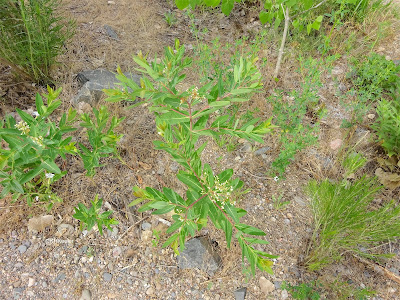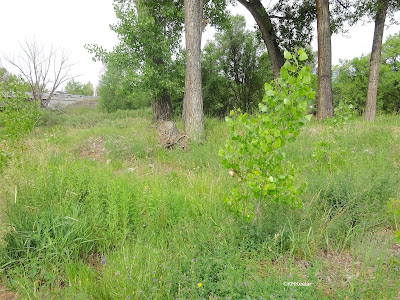I spoke with people--a land owner along the river, a neighbor who regularly walked riverside paths--who wondered whether the riverside would ever recover.
 |
| Looking across the flood zone to the Big Thompson River, early 2014 |
I remember saying that floods are a recurring thing for rivers, so the riverside plants are adapted to flooding. Some have deep roots and, even when the water strips off all the trunk, the roots survive to send up new branches. Some had for years scattered seeds in the river, so mixed in all that sand and gravel were seeds getting their chance. Other plants were killed back to some safe place on shore, but in the summer after the flood, tossed lots of seeds into the barren river banks, to germinate the next spring.
That was theory, though. As the photos above and immediately below show, the situation was pretty bleak.
 |
| Another look at the flood zone |
This month, some seven years after the flood, I went looking for wildflowers at Glade Park. Glade Park, just east of the canyon the Big Thompson River cut into the mountains, was badly flooded in 2013. It was much different in 2020.
I know thta after the flood worried humans cleared out the debris and it is likely they added seeds. Ecological succession will restore ecosystems without human intervention, but particular species of plants cannot reappear if their seeds are not available. In our modern world, a newly-disturbed site may be far from a source of native seeds, so adding seeds can be very helpful.
I found an interesting group of native wildflowers at Glade Park.
Spiderwort, Tradescantia (blue, dayflower family, Commelinaceae) and a vetch (pink, pea family, Fabaceae) were both flowering.
I found a number of plants of the native milkweed, showy milkweed (Asclepias speciosa, dogbane family, Apocynaceae).
A yellow composite, likely hairy false goldenaster, Heterotheca villosa (sunflower family, Asteraceae) was very common in the river forest of Glade Park.
Below is a native four o'clock (Mirabilis, four o'clock family, Nyctaginaceae), in seed. The star-shaped bracts around the flower persist after the petals drop. The dark in the center is a small cluster of ripening seeds.
Perhaps the seeds of those plants were scattered by humans to aid recovery. But the seeds of cottonwoods (Populus deltoides, willow family, Salicaceae) were not. Cottonwoods' tiny seeds must land on wet soil and have only hours to germinate before they die. A river margin stripped of its vegetation is the perfect place of them; moist and sunny. The young cottonwoods in Glade Park are now 5 to 6 feet tall. (People plant cottonwoods, but these are chaotically arranged; people like rows.)
Similarly, while it is possible someone added seeds of Indian hemp (Apocynum cannabinum, dogbane family Apocynaceae), river margins of this region are its natural habitat. I'll bet it self-seeded. And the cluster of leaves in the lower right corner of the photo below is rubber rabbitbrush, Ericameria nauseosa (sunflower family, Asteraceae), another native that people are unlikely to plant. (Rubber rabbitbrush is common enough we ignore it, and it is an aggressive invader of disturbed spots.)
 |
| Indian hemp, Apocynum cannabinum (dogbane family) and in the lower right rubber rabbitbrush (Ericameria nauseosa, sunflower family) |
Glade Park looks weedy and disturbed to the visitor, but it is a county park and human activities disturb plants and let in weeds. There is a good native plant community there, doing well. I think I would call it recovered...until the next flood, of course.
One more wildflower photo, a cinquefoil (Potentilla, rose family, Rosaceae).
Comments and corrections welcome.
Kathy Keeler, A Wandering Botanist
More at awanderingbotanist.com
Join me on Facebook: https://www.facebook.com/AWanderingBotanist









No comments:
Post a Comment